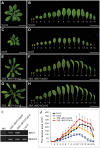The F-box protein MIO1/SLB1 regulates organ size and leaf movement in Medicago truncatula
- PMID: 33506247
- PMCID: PMC8023213
- DOI: 10.1093/jxb/erab033
The F-box protein MIO1/SLB1 regulates organ size and leaf movement in Medicago truncatula
Abstract
The size of leaf and seed organs, determined by the interplay of cell proliferation and expansion, is closely related to the final yield and quality of forage and crops. Yet the cellular and molecular mechanisms underlying organ size modulation remain poorly understood, especially in legumes. Here, MINI ORGAN1 (MIO1), which encodes an F-box protein SMALL LEAF AND BUSHY1 (SLB1) recently reported to control lateral branching in Medicago truncatula, was identified as a key regulator of organ size. We show that loss-of-function of MIO1/SLB1 severely reduced organ size. Conversely, plants overexpressing MIO1/SLB1 had enlarged organs. Cellular analysis revealed that MIO1/SLB1 controlled organ size mainly by modulating primary cell proliferation during the early stages of leaf development. Biochemical analysis revealed that MIO1/SLB1 could form part of SKP1/Cullin/F-box (SCF) E3 ubiquitin ligase complex, to target BIG SEEDS1 (BS1), a repressor of primary cell division, for degradation. Interestingly, we found that MIO1/SLB1 also played a key role in pulvinus development and leaf movement by modulating cell proliferation of the pulvinus as leaves developed. Our study not only demonstrates a conserved role of MIO1/SLB1 in the control of organ size in legumes, but also sheds light on the novel function of MIO1/SLB1 in leaf movement.
Keywords: BIG SEEDS1 (BS1); F-box protein; MINI ORGAN1 (MIO1)/SMALL LEAF AND BUSHY1 (SLB1); SCF E3 ligase; organ size; proteasome-mediated degradation; pulvinus.
© The Author(s) 2021. Published by Oxford University Press on behalf of the Society for Experimental Biology.
Figures







Similar articles
-
SMALL LEAF AND BUSHY1 controls organ size and lateral branching by modulating the stability of BIG SEEDS1 in Medicago truncatula.New Phytol. 2020 Jun;226(5):1399-1412. doi: 10.1111/nph.16449. Epub 2020 Feb 19. New Phytol. 2020. PMID: 31981419 Free PMC article.
-
The MIO1-MtKIX8 module regulates the organ size in Medicago truncatula.Physiol Plant. 2023 Sep-Oct;175(5):e14046. doi: 10.1111/ppl.14046. Physiol Plant. 2023. PMID: 37882293
-
A common F-box gene regulates the leucine homeostasis of Medicago truncatula and Arabidopsis thaliana.Protoplasma. 2022 Mar;259(2):277-290. doi: 10.1007/s00709-021-01662-w. Epub 2021 May 10. Protoplasma. 2022. PMID: 33973099
-
Genetically engineered mouse models for functional studies of SKP1-CUL1-F-box-protein (SCF) E3 ubiquitin ligases.Cell Res. 2013 May;23(5):599-619. doi: 10.1038/cr.2013.44. Epub 2013 Mar 26. Cell Res. 2013. PMID: 23528706 Free PMC article. Review.
-
The role of SCF ubiquitin-ligase complex at the beginning of life.Reprod Biol Endocrinol. 2019 Nov 28;17(1):101. doi: 10.1186/s12958-019-0547-y. Reprod Biol Endocrinol. 2019. PMID: 31779633 Free PMC article. Review.
Cited by
-
The Organ Size and Morphological Change During the Domestication Process of Soybean.Front Plant Sci. 2022 Jun 9;13:913238. doi: 10.3389/fpls.2022.913238. eCollection 2022. Front Plant Sci. 2022. PMID: 35755657 Free PMC article. Review.
-
Identification and Investigation of the Genetic Variations and Candidate Genes Responsible for Seed Weight via GWAS in Paper Mulberry.Int J Mol Sci. 2022 Oct 19;23(20):12520. doi: 10.3390/ijms232012520. Int J Mol Sci. 2022. PMID: 36293375 Free PMC article.
-
Mechanics of Reversible Deformation during Leaf Movement and Regulation of Pulvinus Development in Legumes.Int J Mol Sci. 2022 Sep 6;23(18):10240. doi: 10.3390/ijms231810240. Int J Mol Sci. 2022. PMID: 36142170 Free PMC article. Review.
-
Genetic diversity and genome-wide association study of 13 agronomic traits in 977 Beta vulgaris L. germplasms.BMC Genomics. 2023 Jul 24;24(1):413. doi: 10.1186/s12864-023-09522-y. BMC Genomics. 2023. PMID: 37488485 Free PMC article.
-
Heterotrimeric G-protein subunits regulate plant architecture, pod development, seed size, and symbiotic nodulation in Medicago truncatula.aBIOTECH. 2025 May 7;6(2):141-159. doi: 10.1007/s42994-025-00210-x. eCollection 2025 Jun. aBIOTECH. 2025. PMID: 40641644 Free PMC article.
References
-
- Andriankaja M, Dhondt S, De Bodt S, et al. . 2012. Exit from proliferation during leaf development in Arabidopsis thaliana: a not-so-gradual process. Developmental Cell 22, 64–78. - PubMed
Publication types
MeSH terms
Substances
LinkOut - more resources
Full Text Sources
Other Literature Sources

